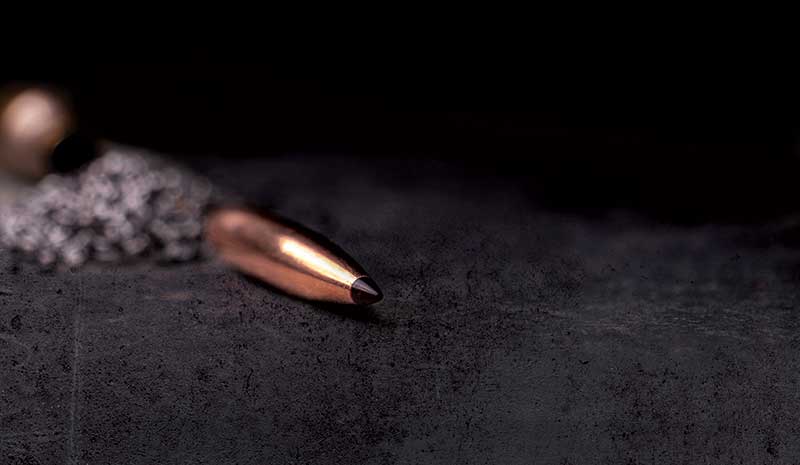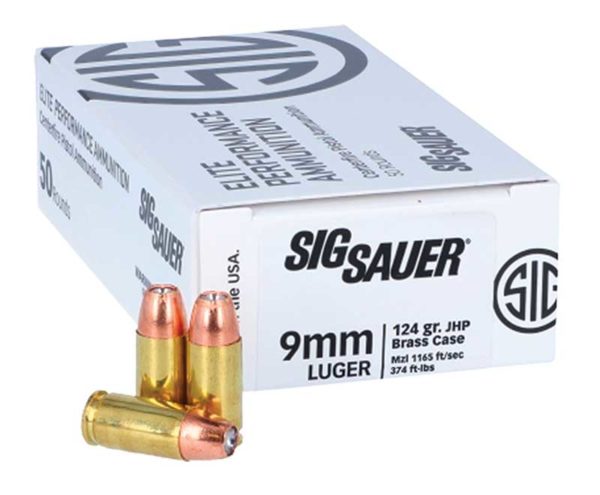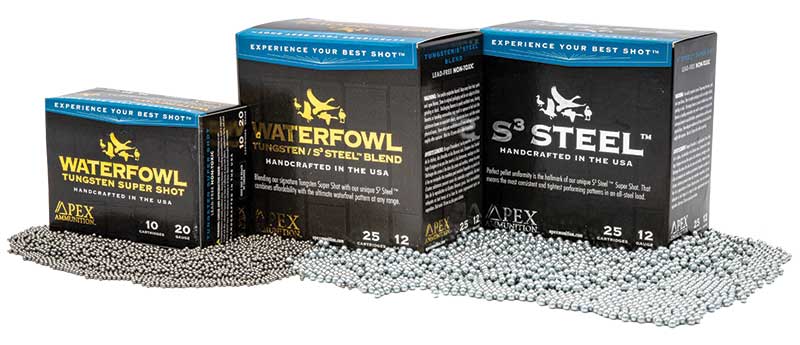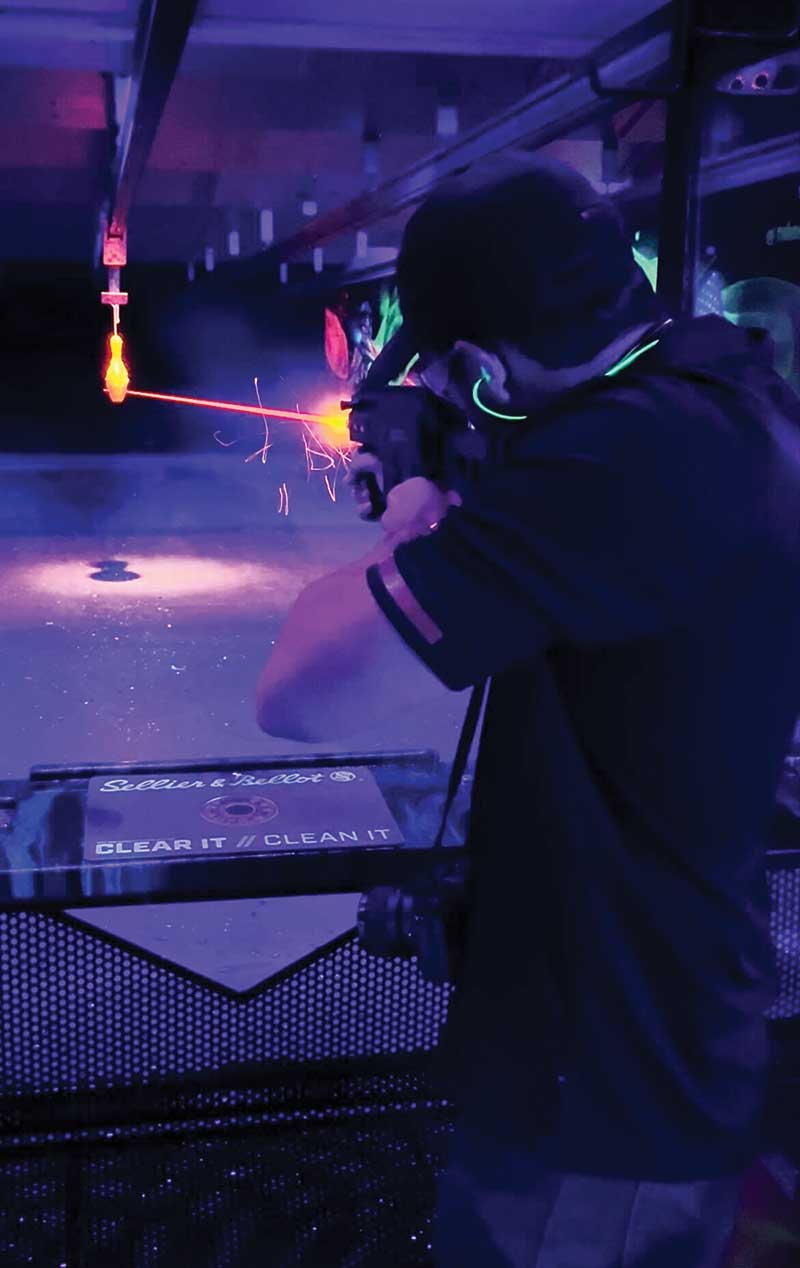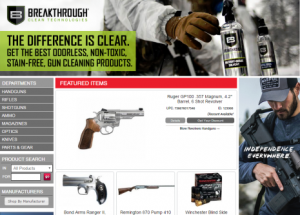Is Ammo Really Back?
State Of The 2022 Ammo Market
PART 1 | The Manufacturer Perspective
Over the past two years, no segment in the shooting, hunting and outdoor industry has been hit quite like the ammunition market. Record-breaking sales in 2020 continued into 2021, and while there is hope 2022 will bring added stability into the market, it’s still likely to be some time before ammunition availability returns to some sort of “normal.”
In Part 1 of this special report, several ammunition makers provided their insights into the market, addressed how dealers can promote the return of “core” calibers, prepare for challenges in the hunting sector and more.
(Editor’s Note: This article was written in mid-May before the tragic school shooting in Uvalde, Texas. It’s too early to tell how much this will influence consumers’ buying habits, but there’s no doubt it will.)
The Return Of High-Demand Calibers
At the macro level, demand isn’t quite to the level it was earlier in the surge — giving ammunition manufacturers a chance to catch up. In welcome news, popular calibers are coming back onto shelves.
“It is certainly not at peak levels,” said Tom Taylor, SIG SAUER CMO and EVP, commercial sales. “Ammo is still selling well, but the high-demand calibers from the surge (9mm and .223, primarily) are generally on the shelf. Other calibers and categories are still harder to find — 6.5 Creedmoor, .380, 10mm and many popular hunting calibers.”
Seth Swerczek, Hornady marketing communications manager, added further confirmation the most popular calibers at the onset of the buying surge are starting to come back.
“What we’ve heard from dealers and distributors, and seen at the local level, is the first ammo people panicked and purchased — 9mm, .223, .308 Win. — has really lightened up,” he said. “Since those three calibers have settled down, hopefully the buying frenzy is starting to show signs of slowing and ultimately stretch into every other category.”
AMMO Inc., makers of Signature, STREAK and stelTH Subsonic lines, is in the closing stages of building a new 170,000 sq. ft. ammunition manufacturing plant in Manitowoc, Wis. This facility will at least double the company’s production capacity and further accelerate the availability of core calibers, according to Director of Sales Anthony Tate.
“We’ve stepped up the production of our three lines, giving the consumer a chance to get out and try our products over the past two years,” he said. “On the retail side, we’ve noticed dealers promote the return of different calibers we hadn’t seen in the past six months.”
APEX Ammunition, launched in 2017 by Jason Lonsberry and U.S. veterans Jared Lewis and Nick Charney, serves turkey and waterfowl hunters. Lonsberry, APEX CEO, shared demand has remained at record levels for his company.
“Fortunately, demand has always been high for us. But according to our dealers, it’s a bottomless pit right now since all other manufacturers are behind the bell curve and there’s no letup in demand in sight,” he said.
Concern For Hunting Ammo Availability
Dealers have written in to SI, sharing their concerns on the availability of hunting ammunition this fall. We asked the manufacturers quoted in this story for their assessments, and dealers should be prepared for stocking difficulties.
“When ammo companies turned their focus to 9mm and .223 during the surge, it’s been challenging to get factories back on track with hunting ammo,” Taylor said. “This may improve by hunting season, but many retailers are already stocking (or will begin very soon) for hunting season, so it’s likely this hunting ammo shortage will drag into hunting season and never fully catch up.”
While Hornady is producing more ammunition than ever before, Swerczek stated the company isn’t willing to sacrifice quality to get more hunting rounds on the shelves. His advice to dealers? Start early, and be prepared to be flexible.
“Keep your eye out when you can — and maybe consider switching to carrying a different bullet weight or product line you haven’t traditionally used,” he said. “Start early, look often and know Hornady is dedicated to making hunting ammunition at volumes we never have before.”
Since APEX is a producer of shotshells, we asked Lonsberry for how today’s demand will impact fall wingshooting.
“We’ll have the APEX Waterfowl and Upland lines ready for shipment to our dealers starting in late summer. Some are even placing their orders now [mid-May],” he said. “We’ll produce more ammo than ever this year and are aiming to fill the void as much as possible. Our anticipation is we’ll still sell out our entire production allotment before the end of the waterfowl season.”
Seth Swerczek, Hornady Marketing Communications Manager
Rising Input Costs, Rising Prices
The past two years have played out a classic case of supply and demand. Skyrocketing demand alone will rise prices. But high demand coupled with supply chain challenges means prices aren’t likely to drop in the foreseeable future.
In last year’s report on the ammunition market, in the June 2021 issue, Swerczek noted demand for lead, rising copper prices and difficulties securing components resulted in a trickle-down effect on cost for the end user. Today, these challenges remain and haven’t been helped by rising gas prices and inflation. That said, manufacturers are powering through to boost supply levels.
“Prices are what they are, and they’ve been impacted by several variables. Production of ammo hasn’t been hindered,” he said. “There are certainly concerns we keep a strong eye on, like primers. The industry partners who manufacture primers have honored their contractual obligations with us, so even though it’s a concern, it’s not a problem. Availability of primers hasn’t impacted us negatively with regard to production.”
With the supply of primers coming into focus, SIG has made plans to be more self-reliant, according to Taylor.
“While SIG is taking steps to become fully independent for supply, we still source some bullets and all primers,” he said. “We’re in the process of building our own primer manufacturing facility and ramping up bullet production, but we’re still reliant (especially) on primers out of eastern Europe. The Russian-Ukraine war has certainly impacted our primer flow. We hope, within months, SIG will be fully self-sufficient.”
Taylor predicts prices will continue to remain elevated.
“While supply is catching up on popular calibers, componentry costs are extremely high and even though product may be showing up on the shelf it is not, nor do we anticipate it getting to, pre-surge prices,” he said.
Ukraine’s Impact
Russia’s invasion of Ukraine has added further fuel to fears of global uncertainty, and the U.S. ammunition market is most certainly going to be impacted.
The ban on the imports of Russian steel-cased ammunition — a significant part of the U.S. ammunition market — went into effect Sept. 2021, which was already set to diminish supply as Form 6 applications are no longer approved (but valid for 24 months).
However, in the wake of war, there are calls for immediate bans of Russian goods in the U.S. May 20, as the firearm industry trade association, NSSF publicly joined these efforts.
“NSSF calls upon the administration to impose a complete and immediate ban on the importation of all Russian goods, including firearms, ammunition and components,” it said in a press release.
As of this writing, the immediate and complete ban on these goods have yet to be realized. The ultimate absence of Russian steel-cased ammunition in the market will impact the pricing structure.
“With steel-case ammo not flowing in, it won’t be able to check the price of brass-cased ammo,” Tate noted. “Ultimately, we’re going to see brass-cased ammo slowly tick up with less supply.”
AMMO Inc. made global headlines with its pledge to donate 1 million rounds of ammunition to the Ukraine Armed Forces just days after the invasion began. The company successfully delivered the shipment in mid-March. Vista Outdoor — through its Remington, CCI, Speer and Federal Ammunition brands — likewise donated 1 million rounds to the Ukraine Armed Forces.
Tom Taylor, SIG SAUER EVP & EVP, Commercial Sales
Marketing Ammo’s Return
Despite ammo availability improving, we at SI have heard firsthand from dealers the latest challenge they’re facing is how to market the return of ammo into their stores.
Matt Nicholson, AMMO Inc. VP of sales and marketing, understands why some dealers and ranges may be hesitant to market ammo availability to customers.
“The dealers and ranges are — for a lack of a better term — in a little bit of a shell shock, since they may not trust the supply before something else happens that drives it back to zero,” he said.
With the summer slowdown coming, Nicholson recommends now is as good a time as any to market the return of ammo on shelves.
“For stores looking to advertise ammo is back, these next two months would be the time to do it — because who knows what’s in store as we move into the fall,” he said. “If I was a range owner, I would be hammering my social media accounts and sending emails because it’s an easy story to tell and probably the best way to reach the most consumers as quickly as possible,” he advised.
Swerczek is optimistic the industry can do a better job of informing the public recreational shooting is more feasible than it was during the height of the demand surge.
“Hopefully we can satiate the market with those calibers people shoot the most, and get the word out there things are becoming a little more stable and prices come back down a little bit,” he said.
With the surge subsiding, Taylor says the industry will be better positioned to communicate the return of product lines to consumers.
“We’re hoping to launch a new program for ranges, and we hope to help communicate high-demand guns and ammo are available,” he said. “Neither of which was doable during the surge.”
Don’t Forget About Fun
It’s been lost in the chaos of the past couple years, but if the industry can successfully market the “fun” side of the shooting sports to first-time gun buyers it will generate longer-term participants. SIG SAUER and AMMO Inc. have recently been involved in events to encourage connection and entertainment.
In May, SIG hosted its inaugural SIG Freedom Days event, which welcomed 4,000+ consumers to the Ben Avery Shooting Complex in Phoenix. Taylor said events like this will help enhance SIG’s most popular lines of ammunition.
“Personal defense seems to continue to be in high demand, but training/range ammo is most popular,” Taylor said. “With millions of new shooters, training/range ammo should continue to grow and SIG will certainly be launching many new programs, such as our recent SIG Freedom Days event, to get more people out shooting.”
Taylor also shared some rather concerning data.
“Our research shows 50% of gun owners buy a gun and never shoot. Only 10% go to the range more than five times per year,” he said. “We’d like to see all gun owners spending more time at the range, which will inherently produce more ammo sales.”
AMMO Inc.’s STREAK line, a nonincendiary tracer round, has been increasing in popularity over the past two years — with ranges showcasing this technology for customers.
“STREAK has a good range application. With it being nonincendiary, we’ve seen ranges take it on and it’s been received well. We’re going to be making a whole lot more of it,” Tate said.
In honor of Star Wars Day (May The Fourth Be With You), AMMO Inc. participated at a range event at the Scottsdale Gun Club in Scottsdale, Ariz., which featured shooting STREAK in a low-light setting and prizes for the best-dressed attendees.
In addition to ranges, Nicholson added demand for STREAK has increased at training centers and in the L.E. market, as well.
“It will help with training and qualifying efforts,” he said.
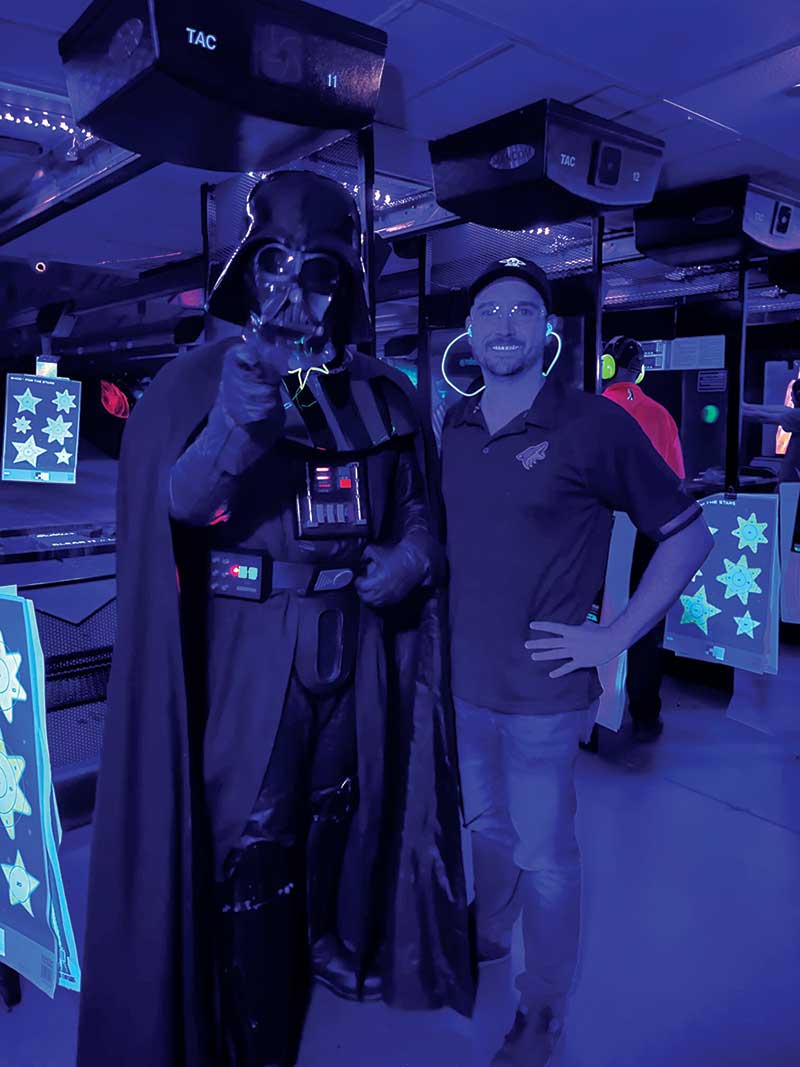
Highlighting the “fun” side of the shooting sports (literally), AMMO Inc. partnered with the Scottsdale Gun Club
on Star Wars Day (May the fourth) to show off its STREAK line of nonincendiary tracer rounds in low-light settings.
AMMO Inc. Director of Sales Anthony Tate says he’s seen more ranges promoting similar events. (Photos: AMMO Inc.)
Where Do We Go From Here?
It’s the million-dollar question we’ve asked since March 2020: When will things go back to “normal”? It’s complicated …
“The crystal ball is still quite hazy,” Swerczek of Hornady stated. “With some of the bulk ammo, there are signs of things slowing down — but it doesn’t always translate to other parts of the market. Demand for match, long-range and hunting SKUs is still off the charts, and the political climate can always make things go backward.”
The midterm election cycle will certainly have an impact on whether or not things return to some sort of normal quickly, according to AMMO Inc.’s Nicholson.
“We’re on the path to ‘normalcy’ but it could be derailed in a heartbeat,” he said. “The Russian ammo ban is going to have a massive impact on the U.S. market, and we’re going to see rising prices and scarcity as a result. Availability of 9mm and .223 is getting there, but other SKUs like 10mm, .45 LC, .45 ACP or even .380 are going to be a struggle for a while. If the midterms see a ‘red wave,’ we get closer to normalcy.”
APEX’s Lonsberry offered the continued logistics challenges have likely pushed a post-pandemic “normal” a couple years away.
“Metals to create brass, components to produce gun powder and horrible logistics issues that affect other industries as well are the main causes of the delay today,”
he stated. “This shortage in raw material supply could last for a couple more years, based on our speculation and conversations with fellow manufacturers.”
There have been lots of ups and downs over the past two years, and though we’re certainly not “out of the woods” yet, there is hope as supply is at least beginning to show signs of recovery. Agree/disagree? Let us know.
Dealers, we invite your feedback: Are you still having trouble getting ammo in store? What are you doing to spread the word once you have product in stock? We want to hear from you: comments@shootingindustry.com.

